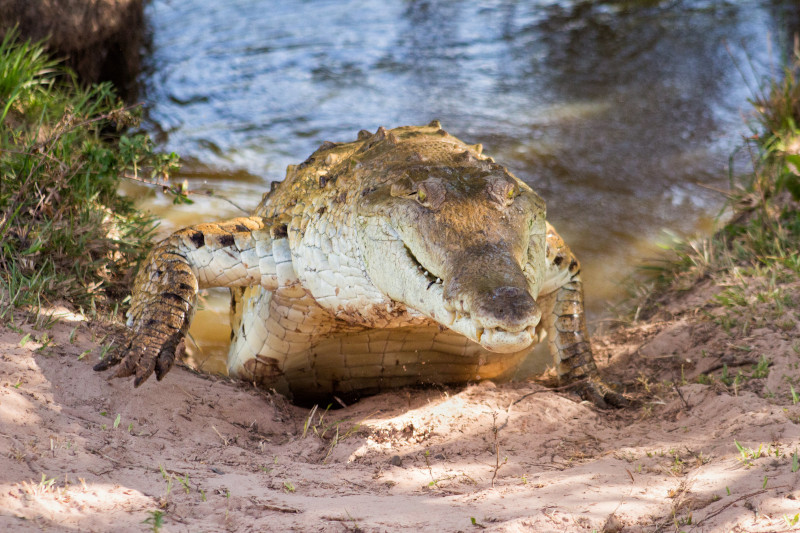
Orinoco Crocodile Facts
- The most frequently used common name for this majestic creation of Nature and evolution remains that of the informative term of Orinoco Crocodile. Presently, the creature has no other broadly accepted general title, at least not in the english language.
- Within the scientific community, however, it’s perhaps better known by its technical moniker. Despite its somewhat cumbersome length, though, that’s relatively easy for the layperson to pronounce. It holds the official epithet of Crocodylus intermedius.
- The highly impressive reptile received this appellation due to the efforts of M. L. Graves. The noted researcher accomplished the first official recognition of the animal as a separate and distinct species. That scientifically noteworthy deed occurred in 1819.
- No matter which of these designations one chooses to use, it’s a magnificent species. Though lesser known than many of its relatives, many experts rank it as one of the largest of them. Experts presently know of no subspecies of the animal, however.
- Sadly, though, the mighty Orinoco Crocodile holds a population base that’s both extremely small and apparently fragile. Though precise numbers remain undetermined, many estimates place its surviving wild population at no more than 250 individuals.
- The IUCN therefore lists the reptile as Critically Endangered on its Red List. While legally protected, it nonetheless still faces threats to its existence. Habitat loss due to human activities and the effects of climate change certainly rank among these.
Related Articles
Orinoco Crocodile Physical Description
The fabulous Orinoco Crocodile immediately captivates those lucky enough to see one, especially in the wild. Yet, it does so for several reasons. That’s because this specific reptile qualifies as both a beautiful specimen and one possessed of respectable size.
Although few individuals today attain the full potential growth of the species, they still reach remarkable measurements. Like many of its relatives, though, it displays a certain degree of the physiological characteristic of sexual dimorphism in regards to this aspect.
More precisely, males typically reach greater lengths and masses than their female counterparts. Today, larger specimens of this gender sometimes achieve head-to-tail totals equaling roughly 13 – 16 ft (4.1 – 4.8 m). Masses range from 1,100 – 1,500 lb (499 – 680 kg).
Females, meanwhile, generally do not manage to grow quite so large. This sex of the amazing work of evolution rarely exceeds 10.7 ft (3.25 m) in total length now. Their average full mass also measures accordingly less. This rarely totals more than 496 lb (225 kg).
But Nature designed the amazing creature for even more impressive statistics. Human culling of the animals for their skins prior to receiving protection slaughtered the largest specimens. Exceptional examples once attained alleged lengths of 22.2 ft (6.78 m).
Apart from size differences, however, the sexes of the intriguing Orinoco Crocodile present the same physical appearance. Overall, the hide usually presents a light tan hue. Variations of this do occur, though, including shades of dark brownish-gray and yellowish.
It’s also easily recognizable due to the shape of its snout. Compared to most of its kindred, this feature develops as relatively long and narrow. Like those same relations, however, its legs evolved short yet powerful. Conversely, the tail develops as strong and lengthy.
- Kingdom: Animalia
- Phylum: Chordata
- Class: Reptilia
- Order: Crocodilia
- Family: Crocodylidae
- Genus: Crocodylus
- Species: C. intermedius
Orinoco Crocodile Distribution, Habitat, and Ecology
Regrettably, the majestic Orinoco Crocodile evolved as native to a highly limited portion of the earth’s surface. The very name of the animal provides a clue to this range, in fact. That’s because it developed as endemic to a specific part of what’s now South America.
More precisely, given the title for the reptile, it appears within the confines of the Orinoco River Basin. Presently, it’s only confirmed inside the borders of Colombia and Venezuela. Evidence indicates that it once appeared across a significantly greater range.
This incredible reptile evolved very specific preferences regarding its choice of habitat. This principally consists of quiet lagoons within its zone of habitation. Scattered individuals do, however, sometimess appear in seasonal freshwater rivers in the same region.
Based on evidence, though, many experts believe it once inhabited other ecosystems, as well. Those consisted of various riparian habitats. These included such diverse types as the waters of tropical forests to the rivers present at the foothills of the Andes.
Just as with its relatives, the Orinoco Crocodile evolved as carnivorous in nature. Few studies exist of its exact habits in this regard, however. The scant evidence currently available to researchers indicates that the majority of its diet consists of various large fish.
It also appears to be an opportunistic hunter, though. Thus, virtually any prey that comes within reach becomes a potential meal for the predator. Other known victims to its appetite include birds, mammals, such as monkeys and deer, invertebrates, and other reptiles.
Mating occurs during the dry season. At this time, they excavate burrows in the riverbanks. An average clutch of eggs numbers 40, with incubation averaging about 3 months. While undetermined for certain, an average lifespan in the wild is though to equal 70-80 years.
Species Sharing Its Range
Check out our other articles on 4 Remarkable Reptiles of Australia, Golden Jackal, Mount Jade, Strawberry Tree, Fire Salamander, Agile Ground Mantis, Great Barracuda, Tufted coquette
